What is a 1-2-1-1 Diamond Press?
A 1-2-1-1 Press commonly called the Diamond Press is an aggressive press designed to create traps in the most advantageous positions for the defense. There are four main areas for the diamond press to trap. The first two being in the corners of the press using the baseline and sideline to assist the trap. The second two being just across half-court on the sidelines. This uses the sideline and half-court line to assist the effectiveness of the trap.
The 1-2-1-1 is called the diamond press due to the initial look of the pressing defensive players. They are setup in a diamond formation. One player starts all the way up the floor guarding the inbounds pass. Two players are usually starting on or around the elbows. One player is at mid-court. And one player is all the back.
The diamond formation leaves the corners of the court open hoping the offense will pass the ball into those areas so the defense can trap. The press has multiple variations in its trapping and rotations that can make every team’s diamond press unique. While the concepts are mostly the same, little nuances can be added or modified to each team. This lets the press be used by all different types of teams.
Advantages of the 1-2-1-1 Diamond Press
1) Aggressive Style of Press with Designed Trap Areas
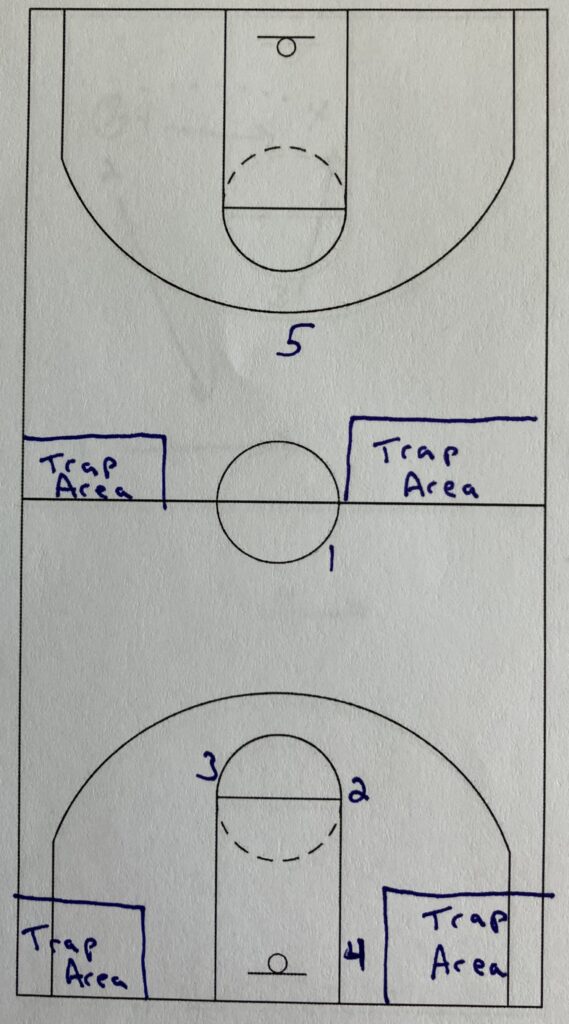
The 1-2-1-1 Diamond Press has four areas of the court where the defense is leading the offense. The first two traps zone are right on the immediate entry pass. The big(4) and either guard(2) or forward(3) trap the first pass in one of the trap zones.
After the initial trap, the diamond press also tries to trap a 2nd time as soon as the ball crosses half-court. This 2nd trap is done with the point(1) and either the guard(2) or forward(3) depending on which side of the court the ball is on.
The ability of the press to get 2 potential traps each possession can put a lot of pressure on the offense to not turn it over. The defense should be able to create some turnovers and in doing so, get easy points in transition.
The 1-2-1-1 press is very aggressive and allows the defense to dictate the tempo of the game. Some presses like the 2-1-2 press and the 1-3-1 press has the defense reacting to the offense whereas the diamond press puts the defense into an attacking mode and forces the offense to be reactionary.
2) Adjustable in Rotations to Keep Offense Unsure
The basic rotations in a 1-2-1-1 Press are the same for any and all teams. However, there are a few spots and adjustments that can be made in the press rotations to make each diamond press unique to each team. Here are two examples of the diamond press having choices as to how to run the press.

The first options on how to rotate is shown above. The ball has been passed into the corner where the big(4) and guard(2) trap. The backside elbow player, in this case the forward(3), can rotate to two different spots. In most diamond presses the forward(3) will rotate back into the middle of the floor to prevent the middle pass coming from the trap. This leaves the backwards reversal pass open for the offense to make.
The 2nd option is to have the forward(3) rotate up to the inbound passer to prevent the quick backwards reversal pass. Since most teams leave this pass open, teams can use the backside elbow defender to rush the inbounder for a possible steal. This leaves the middle pass open which can be dangerous.
Some teams will also rotate the point(1) down into the middle of the floor when the forward(3) rotates up to the inbounder to prevent this middle pass. This rotation will leave the sideline pass wide open for the offense.
With each option the offense has an open pass but by changing the rotations, the defense can keep changing which pass is going to be open. The offense can never get into a routine which keeps the mental pressure of the 1-2-1-1 press very high. Any wrong decision by the offense should lead to a turnover.
The other big adjustable rotation is the backside elbow defender rotating out of the middle when the ball is reversed out of the initial trap. I will explain this rotation later when talking about the positions of the 1-2-1-1 press.
3) Simple Rotations Makes Learning the Press Easier
The defense can be complex by having multiple rotations but the 1-2-1-1 press can also be simplified by making the rotations very easy to learn and execute. This type of simplicity to complexity allows the diamond press to be used at the younger grade levels all the way up into high school and college. As the kids get older with a higher basketball IQ, the diamond press can be adjusted to having the players do a lot more.
However, the diamond press can also be taught in a way that the basketball intelligence level of the players can be minimal. The diamond press is usually one of the first presses I install because it is simply to teach. Once the players understand the simple, then I will make my adjustments and changes when needed.
At the beginning of installing the press, 3 players are doing the same thing no matter which side the ball is passed into. The guard(2) and forward(3) are the only 2 players that have different tasks depending on whether they are ballside or backside on the first pass. This creates a press that has the players doing the same thing every time which makes the pass easier to learn and execute.
Disadvantages of the 1-2-1-1 Diamond Press
1) Ball Must Stay Out of Middle
The 1-2-1-1 Diamond Press has the middle player start in the middle of the court. On the entry pass the middle player and backside elbow player are moving. The middle is moving out of the middle and towards the sideline. The backside elbow player is moving from the elbow back into the middle of the court. A quick pass to an offensive player in the middle of floor immediately gets the ball past 3 defensive players and possibly a 4th. A single pass in a press that beats 3 or 4 defenders must be prevented by the defense.
The 1-3-1 Press or 2-3 Tandem Press leaves a defender in the middle of the court. The 1-2-1-1 diamond press has constant shifting on which defender is covering the middle of the court with each offensive pass. This leaves the middle of the court open and vulnerable for the offense to make a pass into the middle of the court. This is the weakness of the defense.
The middle pass is the weakness of the 1-2-1-1 diamond press but also the trapping aspects of the press are all centered around trapping in the corners using the sidelines as an extra defender. The only way to trap is to get the ball to the sideline. That is where the advantage of the press is and where the ball needs to be for the diamond press to work properly. An offense keeping the ball in the middle of the floor keeps the defense from working.
2) Middle Player Must Be Quick to Cover Sideline to Sideline
The key to the 1-2-1-1 diamond press is the coverage ability of the middle player. They have to anticipate and be quick enough to get to the ballside sideline on the entry pass. A team that is able to make an entry pass followed by a quick sideline pass will beat the diamond press easily. The middle defender must be fast enough to cover the sideline as soon as the ball is entered into the court.
The middle defender must also be quick enough to cover sideline to sideline in case of a reversal pass. After the initial trap, there is a chance for a 2nd trap if the offense reverses the basketball. The key is the middle defender and initial backside elbow defender. The elbow defender should not struggle to get into position for a 2nd trap but the middle defender must be able to sprint across the entire floor to be in position for that trap. This is not an easy run to make. The ability to make the run across the floor gives the diamond press 2 chances at a trap instead of just 1 trap.
The middle defender in the 1-2-1-1 very important. They are the most likely player to intercept a pass during the press. The middle defender must anticipate movement rather than react to movement. They have to have an understanding of how the offense is going to move with and without the ball to be in the best positions for deflections or steals. A good middle defender can turn the diamond press from a good press into a great press.
3) Ball Reversals Beat the Trap
The 1-2-1-1 Diamond Press tries to trap quickly off of the inbounds pass. It is designed to get the ball to one side of the floor and prevent any pass coming out of the trap. If a court is cut in half from basket to basket, then all 5 defenders should be on the same side as the trap is occurring. This leaves the entire other side of the court completely empty of any defender.
Because the defense has everybody on the same side of the court, any reversal pass makes every defender have to change their positions. A reversal pass shifts the entire press making it very difficult for the defense to recover in enough time to continue pressing. There are some things a defense can do to counter a reversal pass that I will discuss in the next segment. But good ball movement gets the defense chasing which opens up driving and passing lanes making the press ineffective.
Positions of a 1-2-1-1 Diamond Press
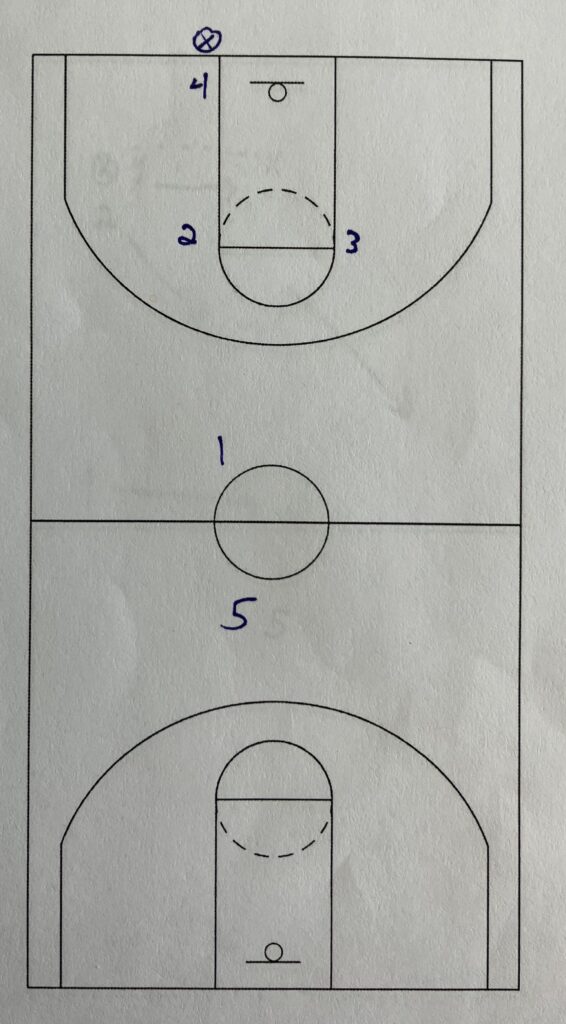
This is the regular starting set up of the 1-2-1-1 Diamond Press. The point(4) should be long and quick. The ability to trap will depend on them. The middle(1) needs to be smart and anticipate well. They also need to be quick enough to cover sideline to sideline quickly. The elbow defenders(2 and 3) are sometimes the players left over after putting the point and middle defenders in. The back(5) is normally the center who is usually the slowest player of the 5. The back(5) is going to be a rim protector in most cases if the press does not work.
I will detail each player better in the Personnel Needed section. This is just a quick simple breakdown of each spot.
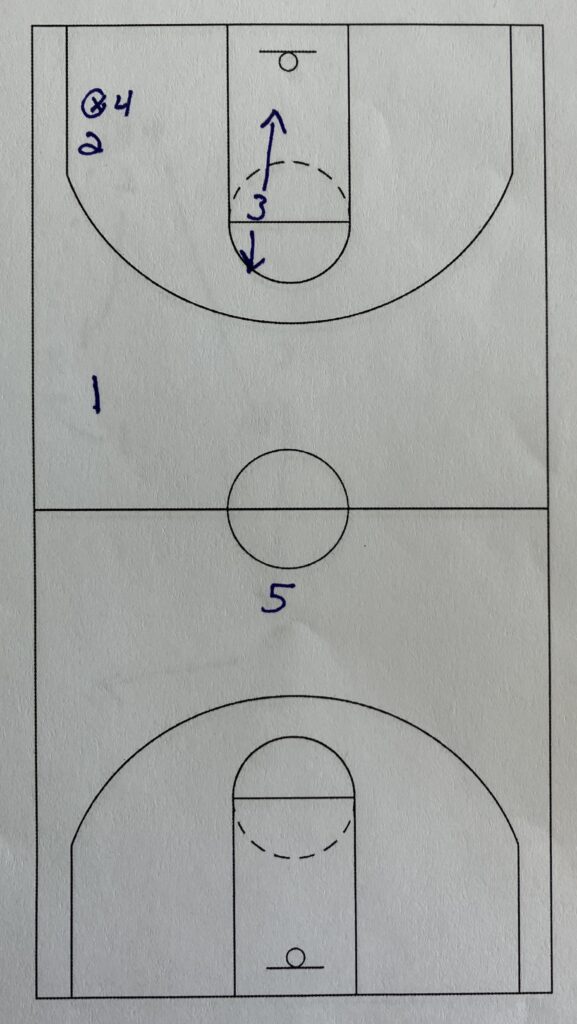
The first positioning is on the entry pass. The point(4) and ballside elbow(2) are trapping. The middle(1) is covering the sideline pass. The back(5) is covering the long diagonal pass as well as being the safety in the press.
The backside elbow(3) is going to drop back into the middle of the court to cover any middle pass. This forces the offense to only have the backwards reversal pass available to them. This is normally throwing the ball back to the inbounds passer of the offense. This keeps all 5 defenders in front of the ball and allows the defense to rotate back to original positions without giving the offense a chance of attacking the basket with an advantage.
However, if the offense does not put anybody in the middle, as in running a 1-2-2 offensive setup without flashing players into the middle, or if the offense will cut their inbounds passer straight to the middle, then I will send the backside elbow(3) straight to the inbounds passer on the entry pass. This leaves the middle wide open but if I know ahead of time or notice during the game the offense not having anybody in the middle then I will send the backside elbow(3) up and be more aggressive in the press.
Offensively sending the inbounds pass straight to the middle of the press can be effective in helping to break the 1-2-1-1 Diamond Press. The defense can counter this by sending the backside elbow(3) defender running up to the inbounds passer after the inbounds pass. If the backside elbow(3) defender can cut in front of the inbounds passer, then the defense should be able to get steals against an offense using this strategy.
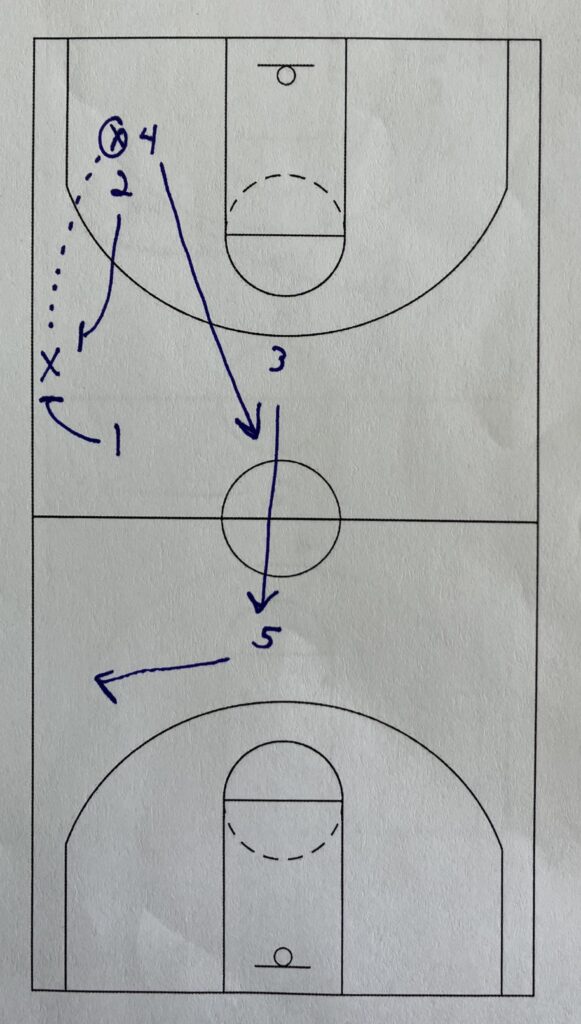
After the inbounds pass, what if the offense is able to pass the ball up the sideline? The middle(1) is cutting the sideline off. The ballside elbow(2) is following the ball to try and trap the ball. These two players are looking to trap while the other 3 players are in a straight retreat back to the defensive end. A pass into the middle or up the sideline can lead to an offensive layup very quickly.
For me, if the offense is able to make either of those passes, then the defense is sprinting back into the half-court and ending the press for that possession. I want to trap in a press, but if the offense is able to beat the trapping press, then I want to stop any layups and try to press and trap again in the next possession.
A pass up the sideline will have the back(5) rotate around towards ballside. The backside elbow(3) runs back towards the basket. The point(4) is sprinting back into the middle. These 3 retreating defenders are trying to cover the next pass options to slow the offense down and give the defense a chance to guard in the half-court.
This is why the middle(1) is a critical player in the press by preventing this up the sideline pass. A pass up the sideline or into the middle will normally beat the 1-2-1-1 diamond press. The press can rotate to this pass but it opens up the back end of the press and makes the diamond press very vulnerable to giving up a layup. The only pass the defense wants to see the offense make is the backwards reversal pass.
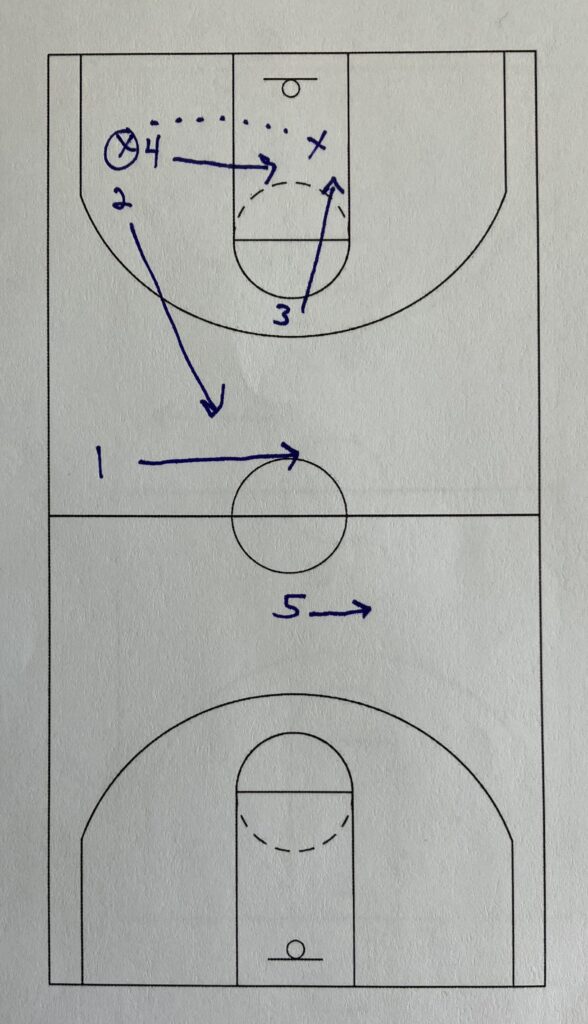
The backwards reversal pass has 3 different options on how to guard the ball once in this position. The first option is shown here where the backside elbow(3) rushes the ball. The point(4) sprints to the ball for a possible trap. The middle(1) runs back into the middle. The ballside elbow(2) is running back into the middle as well.
This leaves both sidelines wide open. With the backside elbow(3) rushing the ball, the middle of the court is wide open for a possible pass. This is open until either the middle(1) or ballside elbow(2) get back into the middle of the floor. Due to the amount of the court being open, this is the rotation I prefer the least.
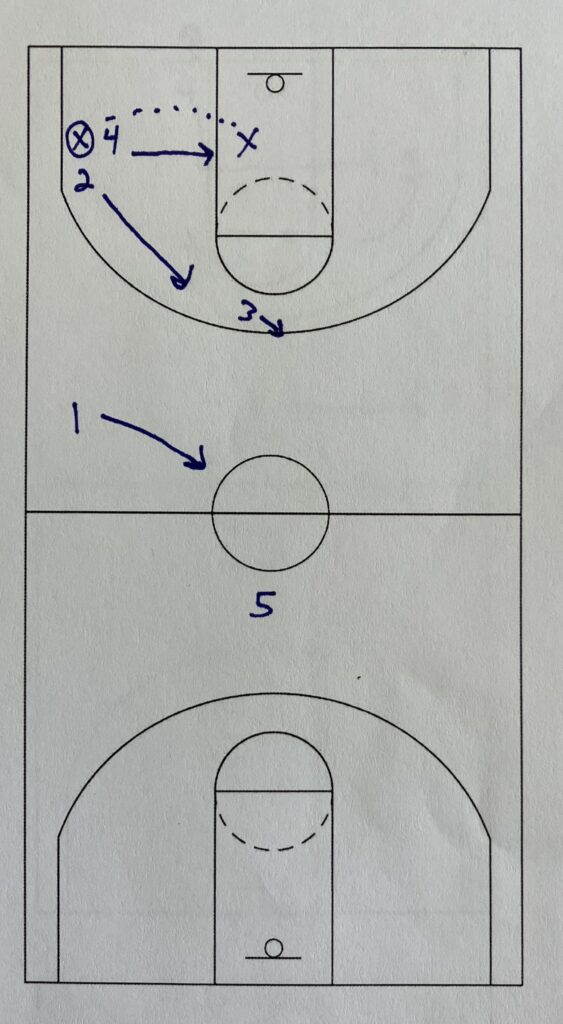
This 2nd defensive rotation option is better than the previous rotation but I prefer the last rotation the most. This rotation has the backside elbow(3) defender stay in the middle. The middle(1) comes back into the middle of the court. The ballside elbow(2) runs back into the middle of the court. And the point(4) runs after the ball.
This rotation prevents the middle pass being made because the backside elbow(3) is staying in that spot. This means the offensive player catching the reversal pass might not have a clear pass to anybody. Without a clear pass, the defense might have enough time to basically reset in the initial spots of the press and restart the defensive possession from this point.

This is the 3rd option and the one I use most often. On the reversal pass, the point(4) chases the ball. The backside elbow(3) “fakes and goes.” The backside elbow(3) takes a jab step towards the ball and then sprints out towards the next reversal pass up the sideline. The middle(1) comes back in line with the ball. And the ballside elbow(2) is sprinting to the middle to try and prevent any middle pass.
I like the fake and go by the backside elbow(3) player. They are trying to get the ball handler to make the next pass up the backside sideline. The jab step tries to get the ball handler to make the pass and as the pass is being made the backside elbow(3) is already sprinting to its intended location. This can speed up the potential 2nd trap. This can also lead to more deflections by the backside elbow(3). I have also seen the ball handler travel because they see the backside elbow(3) running away in the middle of their pass. The ball handler then tries to stop their pass which can lead to travels.
I like this option the best on the reversal pass because it can cause turnovers, but it is more able to keep pressure on the offense while not getting beat entirely and giving up a layup. It has just the right amount of aggressiveness to defensiveness whereas the other two options are either completely aggressive or defensive. This option has a little bit of both.
Trapping out of a 1-2-1-1 Diamond Press
There are four main traps in a 1-2-1-1 Diamond Press. Other traps may occur with the proper rotations but there are four traps that are designed to occur with the 1-2-1-1 Diamond Press.
The first two are off of the initial entrance pass to either side.


On the entry pass, the elbow defender(2 or 3) is cutting the sideline off. The other elbow defender(2 or 3) is moving into the middle. They are stopping any pass into the middle of the press. The middle(1) is running to the sideline to prevent any sideline pass. The back(5) is looking to steal any long diagonal pass out of the trap.
The key to the trap is the point(4) running a L-cut to the trap. The first step or two by the point(4) should be back towards the defensive rim. Then they should sprint to the trap. Without these back steps, the offensive player can easily split the trap as it is coming towards them. Any dribble made by the offense should be backwards. This only occurs with the point(4) running an L-cut.
The trap takes place on either side of the floor but it is much better for the trap if the pass is made to the near corner. It reduces the space the point(4) has to cover to get into the 1st trap. I like to have my point(4) stand almost under the basket to prevent the long pass into the far side corner. This helps to push the offense to make the entry pass into the near side corner.


These are the same secondary traps but differ on which side the ball starts on with the 1st trap. This also helps explain why I like the backside elbow defender to fake and go.
On the quick reversal, the backside elbow defender is sprinting ahead of the ball to stop the offensive player from dribbling up the sideline. I have the trap taking place in front of the half-court line but this should take place right after half-court to give the defense both the sideline and half-court line as additional problem areas for the offense.
The middle(1) is sprinting across the floor to close the trap as the backside elbow cuts the forward dribble off. However, if the middle(1) is able to stop the ball going up the floor, then the backside elbow will change into the side trap defender. This is a skill that can be worked on in practice so the players can read each other to know who has the better angle to stop the dribble and who will be second to close the trap off from the middle.
The back(5) is sliding over towards the sideline depending on how the offense is positioned.
The ballside elbow(2 or 3) is sprinting straight back to the lane. This is a long run by the ballside elbow(2 or 3) but can make this press better when players are willing to put out the effort needed in this run. The reason why is because of the possible deflection that the ballside elbow(2 or 3) can get at the end of the sprint right near the basket.
On the quick reversal, the back(5) slides over to stop the ball. The offense has a chance to make one more pass across for an easy layup. The ballside elbow(2 or 3) can make the sprint and get a deflection to prevent the offense from scoring. It takes away points but also demoralizes the opponent because they have done everything well and beat the press but they are still not rewarded at the end of the play.
Finally, the point(4) is sprinting into the middle of the court looking for any offensive player that is there to cover. They are looking to deflect any middle pass out of the 2nd trap. If the offense is able to make the middle pass, then the point(4) is looking for a back tap on the ball to knock it loose.
Personnel Needed for a 1-2-1-1 Diamond Press
The key players in a 1-2-1-1 diamond press are the point(4) and the middle(1) players. The diamond press is ineffective without the right players in these two spots. However, with the right players in these two spots, the diamond press can be a great chance to apply a lot of pressure to an opposing team.
The point(4) should be able to run fast and have some height or length to them. A stretch four who can run is the perfect player for this position. The point(4) sets the tone for the entire press. They need to be energetic and going 110 miles an hour. They are going to be chasing the ball so they need to be moving almost to the point of being out of control.
A true point(4) player should not be able to stay in the game longer than 4 or 5 possessions without needing a break or a change in the defense. A team should not be able to run the 1-2-1-1 diamond press all game unless they are constantly rotating a new point(4) player in every few possessions.
The other key player in a 1-2-1-1 diamond press is the middle(1). They need to be quick, smart, and anticipate. They are required to cover sideline to sideline so they need to be fast. They need to be in the right spot to trap the ball at the right exact moment. This requires them to have a high basketball IQ and understand where the offense is going to pass the ball one or two passes before it happens.
I will sometimes sacrifice speed for smarts knowing the intelligent player will make up for the lack of speed by being in the right spot at the right moment. Without these two players, I will look more at running the 2-2-1 box press instead of the 1-2-1-1 diamond press.
Keys to a 1-2-1-1 Diamond Press
1) Good Initial Trap
The first key is getting a good initial trap for a good 1-2-1-1 diamond press to work. This initial trap puts immediate pressure on the offense. This trap is trying to speed up the offense to make mistakes. This first trap can set the tone of the press and make the offense play reactionary basketball.
If the defense is unable to get a good first trap, then the offense will be able to pass the ball more easily before the trap gets there. Once that pass is made, the defense will be chasing the offense for the rest of the possession of the press. A lack of a good first trap puts the defense at a disadvantage. The initial trap sets the tone for the entire possession as to which team is being the aggressor and which team is reacting. It is always an advantage to being the team setting the tone.
2) Be Aggressive but Know When to Retreat
The 1-2-1-1 diamond press is a very aggressive press. The aggressiveness of the press can also give the offense easy scoring chances if the press gets beat. The diamond press can reward a defense with steals and easy layups. It also is very risky because if the offense is able to beat the press, then the offense will have a chance at an easy layup. The defense is committing 4 players into the press. That leaves only one player back to stop the offense if the press is beaten.
The defense can help to reduce the risk involved in the press by knowing when to retreat back into a half-court defense. The defense is trying to get steals in the press, but at the same time it must not let the offense get easy layups. The ability of the defense to understand when the offense has the advantage and immediately sprint back into a half-court defense can help to minimize the risk of the press. Sometimes the best outcome for the defense is to simply not give up an easy basket.
Understanding the fine line between aggression and stupidity can be the difference in winning and losing games. Attempting to stay in the press after the offense has the advantage is stupid. This stupidity can lead to the offense gaining easy points against the defense. The press should be very aggressive and maintain the aggressiveness until the offense gets around the trapping aspect of the defense. At that point the defense should retreat to prevent the offense from scoring.
3) Keep the Ball Out of the Middle
The 1-2-1-1 diamond press needs to have the ball on the sideline so the rotations and traps of the diamond press work. When the ball is in the middle of the court, the press and defense is working to get the ball to a sideline. The point(4) is tasked with getting the ball out of the middle and keeping it on the sideline.
The offense can keep the press ineffective by either keeping the ball in the middle or by making passes into the middle of the court. The 1-2-1-1 diamond press is not designed to guard against the ball being in the middle of the floor. This is one of the struggles between the offense and defense that determines how effective or ineffective the diamond press will be.
Youth Basketball and the 1-2-1-1 Diamond Press
The 1-2-1-1 Diamond Press is a great press for youth basketball if there is going to be pressing allowed. The rotations and rules of the press are easy and simple. The need for certain types of players is not really necessary. The first pass starts the press and trapping so the defense does not have to manipulate the offense into putting the ball into trapping areas.
All of these things make the ability to teach and learn the 1-2-1-1 diamond press easier than most of the other presses. The simplicity makes the press better at the youth level because the basketball intelligence at the youth level can be all over the place with the players. This would be the first zone press I would install if I were coaching a youth team to press.
Conclusion
The 1-2-1-1 Diamond Press is a great zone press to use at any level. At the youth level, it can be used with any team. As the players get older, the speed and size of the point(4) player is a must. With the right player, the 1-2-1-1 diamond press can be used through high school and I have even seen it used at the Division 1 level.
The press is easy to learn and run. It will not overload the players with a bunch of rules and reads. It has a few simple concepts. Once the players react correctly to the position of the ball, it can be used in game situations and be effective.
I really like to use the 1-2-1-1 diamond press to affect tempo. If the game is going too slow or if my team is not playing with enough energy, then the 1-2-1-1 press can help to fix both those problems. I also like to use the diamond press as a surprise tactic to try and steal a basket or two.
I will jump into the press after a made free throw as a one possession defense to try and catch the offense unaware. With the press being really aggressive, the trap can happen before the offense even has a chance to realize what is taking place.
While the 1-2-1-1 diamond press does have some faults, the rewards that the press can provide far outweigh the risks in my opinion to a certain extent. And when you are able to get deflections and steals out of the press, the entire game is made easier.


2 thoughts on “1-2-1-1 Press Defense-Diamond Press”